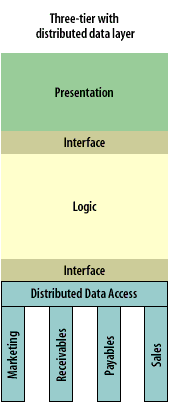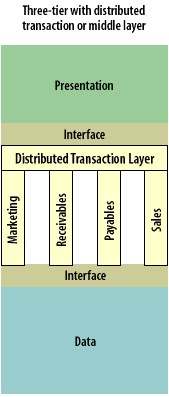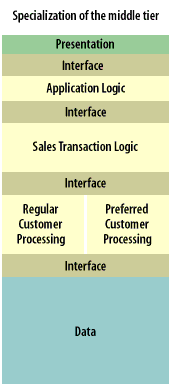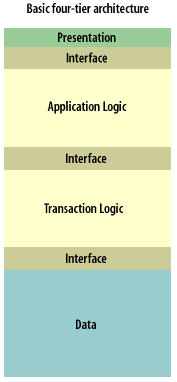| Lesson 6 | Additional n-tier architectures |
| Objective | Explain four additional types of partitioning in an n-tier approach. |
Additional n-tier Architectures
Multiple data sources
In the two- and three-tier architectures it was easy to see that there could be many client applications. We assumed that the middle and bottom tiers were centralized. But could not these tiers be as diverse as the client applications? For example, if you have a nationwide company divided into regions, it is very likely that the data for each region is in a different location.
If so, then the bottom tier is actually a collection of partitions with similar responsibilities but different content.
Not only do you separate the bottom layer, but you must also provide a new interface between the middle tier and the new set of data partitions.
Not only do you separate the bottom layer, but you must also provide a new interface between the middle tier and the new set of data partitions.

Multiple transaction servers
Consider departmental systems where different servers handle different types of transactions. Order processing handles order fulfillment, while transactions and accounts receivable handles billing and payment transactions.
The middle tier, too, is divided into numerous partitions.
The middle tier, too, is divided into numerous partitions.

Specialization
Changing Design
In some environments there are specialized processes for special cases. Preferred customers may have their orders and their billing handled differently. In this case there may be a layering within the transaction tier itself.
In some environments there are specialized processes for special cases. Preferred customers may have their orders and their billing handled differently. In this case there may be a layering within the transaction tier itself.

Thin clients
The advent of the Web has driven the need for very small client applications. What Web applications really require is to separate the interface (the screen presentation) from the logic that governs the behavior of the interface. This setup allows much smaller client
applications, faster downloads, and better access to services in the lower tiers. This type of partitioning has led to technologies like Web servers and Java servlet applications.

Additional Partitioning Types - Quiz
Click the Quiz link below to test what you have learned in the last few lessons.
Additional Partitioning Types - Quiz
Additional Partitioning Types - Quiz